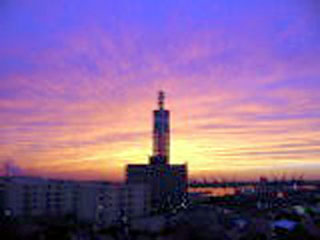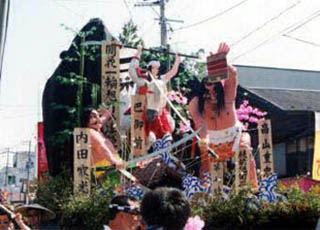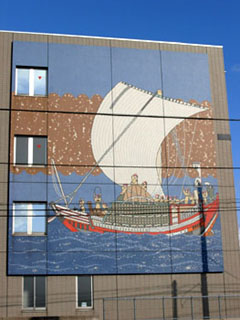Overview of the tube
The Akita Rinko Police Station has jurisdiction over the northern part of Akita City, centered on Akita Port, among the three police stations in Akita City located in the central part of Akita Prefecture.
Transportation is via the Akita Expressway, which is connected to the Tohoku Expressway, and National Route 7, which connects the JR Ou Line to the JR Akita Shinkansen, and has a ferry route from Hokkaido to Fukui.
A 360-degree panorama from the observation deck of the 143m-high Selion Tower near the police station offers a panoramic view of the nature of the four seasons, such as the Oga Peninsula, Mt. Taihei, Mt.

History in the jurisdiction
The Tsuchizaki area is a port town that developed at the mouth of the Omono River, the prefecture's largest river.
At the end of the Muromachi period (1573), it flourished as one of the Seven Minato Minato in the Sea of Japan by the "Shufu Shimoku", and Miki Ando rebuilt Minato Castle in the site of the present Shinmeisha.
In Keicho 7 (1602), Yoshinobu Satake was appointed Minato Castle from Hitachi in place of Ando, but Mr. Satake built a castle in Kubota the year after the enclosement and abolished and demolished Minato Castle.
Under the Satake feudal politics, the westbound ship Kitamae-ship carried the clan rice and commercial rice to Osaka, and transported cotton, tea, salt, paper, etc. to the down load, and Tsuchisaki Minato was thriving.
In the Meiji era, the port movement occurred due to the movement of the river core due to the accumulation of monsoon and sedimentation, and the construction of the main stream of the Omonogawa River was carried out for 22 years from 1926, and completed in 1938.
Along with the river renovation, the port construction ceremony was held in 1958, and port construction was undertaken. However, construction was forced to be canceled due to the war, and many changes occurred. Tsuchizaki Port was merged with the city and renamed Akita Port, and since then it has been fully developed as a modern port.
At present, based on the Port Renaissance 21 business plan that began in 1988, Selion, Selion Lista, and Akita Marina have been opened one after another, and are expected to develop in both logistics and tourism in the prefecture.


History of Akita Rinko Police Station
| November Meiji 8 | Established as Akita Police Station "Tsuchizaki Tonjo" |
|---|---|
| April Meiji 24 | Supervises Gojome and Funakoshi branch offices as Tsuchizaki Police Station |
| November 1971 | Newly built at 8 Kagacho, Tsuchizaki Port (currently Tsukizaki Branch of Akita Bank) |
| March 1948 | Renamed as Tsuchizaki Police Station in Akita City due to police system reform |
| July 1954 | Reopened as Tsuchizaki Police Station in Akita Prefecture due to revision of the Police Law |
| May 1955 | Renamed as Akita Police Station Tsuchizaki Police Station after consolidation |
| August 1964 | Independent from Akita Station, promoted to Akita Rinko Police Station |
| January 1965 | Government building relocated to current location |
| November 1996 | Government building newly built at the current location |
Government building facility information
Overview
| location | 3-18, Nishi 3-chome, Tsuchizaki-ko, Akita-shi |
|---|---|
| Completion date | November 28, 1996 |
| Site area | 4,600 |
| Total floor area | 2,853 |
| Construction | 4-story reinforced concrete |
Structure: 4 stories reinforced concrete
| 4F | Large conference room, Judo / Kendo hall |
|---|---|
| 3F | Small meeting room, detention office |
| 2F | Transportation Division, Criminal Division, Life Safety Division, Lobby, Consultation Room (Trouble) |
| 1F | Regional Section, Toilets for the Handicapped, Accounting Section, (Night Reception), Lobby, Security Section, Chief Office |
